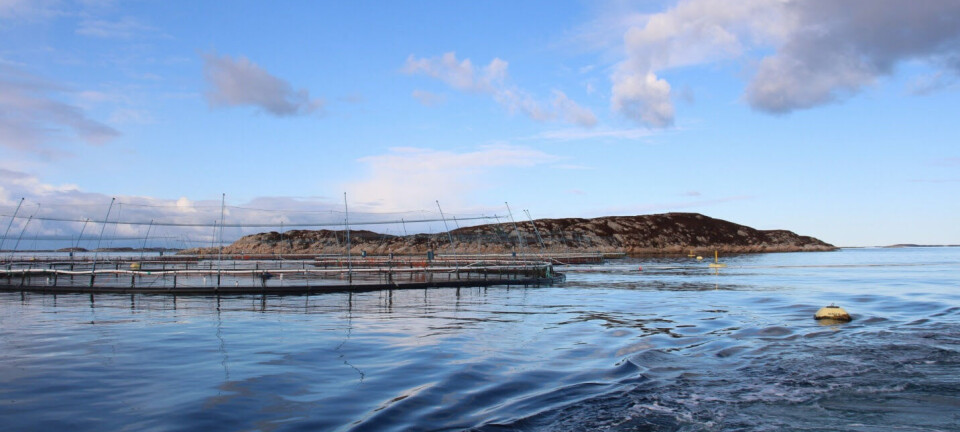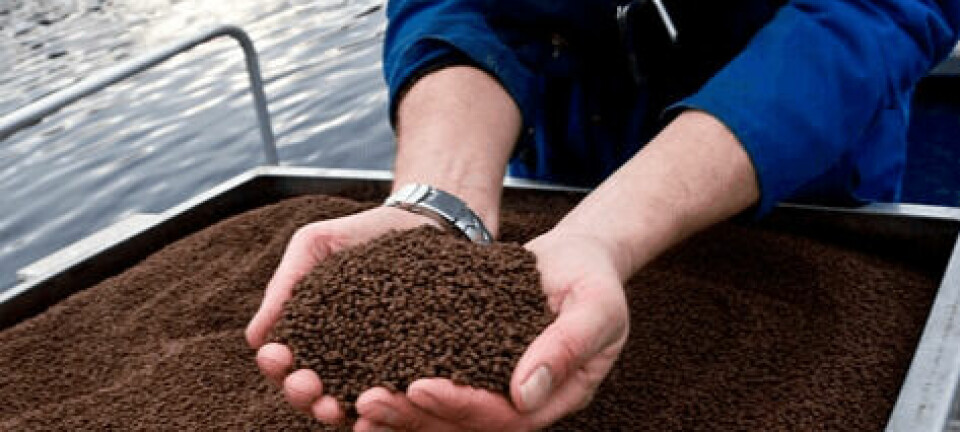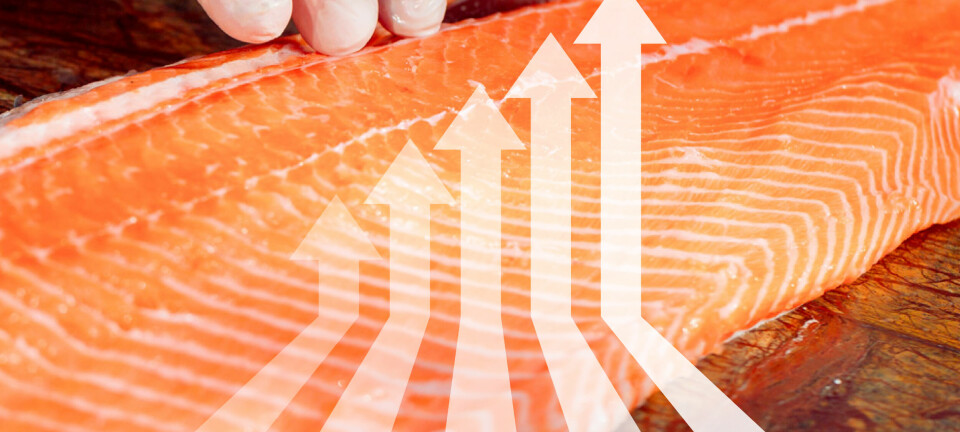Notes on the behaviour of lumpfish (Cyclopterus lumpus L.) in sea pens with Atlantic salmon present
PATRICK REYNOLDS; GERHARD ELIASSEN: GILDESKÅL FORSKNINGSSTASJON. TOR ANDERS ELVERGÅRD: NORDLAKS AS. THOR ARNE HANGSTAD; ATLE FOSS; ERIK VIKINGSTAD and ALBERT K. IMSLAND: AKVAPLAN NIVA.pat.reynolds@gifas.no
Attempts to reduce the level of sea lice in sea pens have been a major goal ever since the 1970s, not only as an economic concern but also in terms of animal welfare and potential costs for the ecosystem. Today lice infestations are mainly regulated with the aid of chemoterepautants, but increasing resistance to delousing agents is an emerging problem. Today, cleaner-fish present the only environmentally friendly alternative to chemical de-lousing of salmonids. However, the cleaner-fish species currently in use for biological delousing, e.g. Ballan wrasse, Labrus bergylta and goldsinny wrasse, Ctenolabrus rupestris, are temperature-sensitive, making them unfit for use under low (< 6 0 C) temperatures. As a cold-water cleaner-fish, the common lumpfish, Cyclopterus lumpus L, has been suggested. Up to now very little has been published concerning behaviour of lumpfish. A limited number of studies have been performed with wild lumpish, including larvae, juveniles and adults. However, no published knowledge exists describing the behavioural interaction between lumpfish and Atlantic salmon under controlled conditions in sea cages. The aim of this study was to investigate, and to quantify, behavioural interactions between lumpfish and Atlantic salmon under controlled conditions.
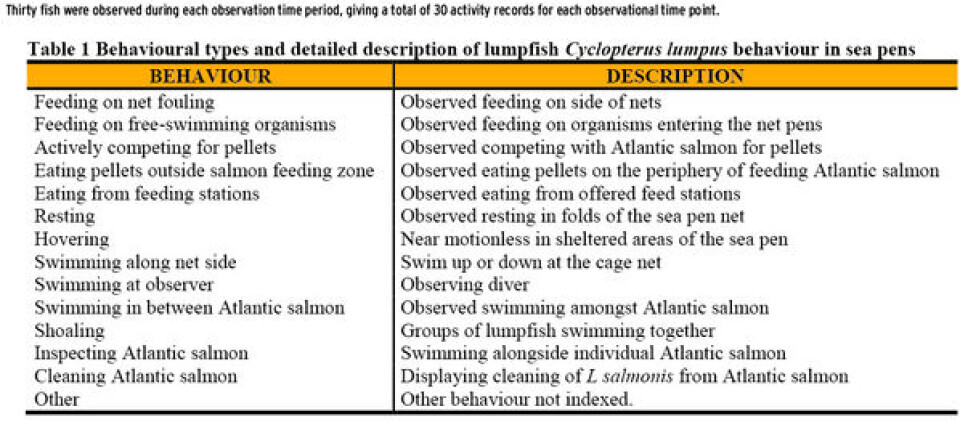
Methods Atlantic salmon were counted and randomly distributed between four sea pens of 125 m3 with 100 fish in each sea pen. Two sea pens of Atlantic salmon were further stocked with 40 juvenile lumpfish. In addition, 40 lumpfish were reared without salmon in two sea pens of 125 m3 as control groups. The study lasted for 56 days and was terminated on 25 January 2012. The fish in the sea cages were fed with a commercial salmon feed (Biomar CPK) to satiation by hand. One distinctive meal was fed each day and some feed pellets were crushed on a daily basis to ensure that the lumpfish had a food source due to lack of natural food sources in winter. Intra- and interspecific behaviour was recorded at regular intervals throughout the trial period. Behavioural observations commenced 2 weeks after the cages were established to allow for an acclimation period. Behaviour was classified (Table 1) by recording the principal activity of individual fish at 30 second intervals.
Thirty fish were observed during each observation time period, giving a total of 30 activity records for each observational time point.
Results From the observations recorded over time, lumpfish exhibit a limited palette of behavioural traits. In the sea pens without Atlantic salmon (Fig. 1a), the majority of daylight time was spent actively foraging for food (over 50 % of all recorded observations over time). In the sea pens where lumpfish and Atlantic salmon were reared together (Fig. 1b), a greater variety of types of behaviour was recorded.

However, the dominant types of behaviour observed were feeding-related (approximately 60 %) and no differences were seen in overall foraging behaviour or in the time spent feeding on net fouling. If not feeding or foraging, the fish were found to be either resting within the floating seaweed within the cage or hovering just under the weed. The lumpfish spent more time resting when reared alone (Fig. 1b). Lumpfish were found to compete with the Atlantic salmon for access to pellets during feeding and were observed swimming within the shoal of salmon when feeding commenced. Direct observations of lumpfish cleaning L. salmonis of Atlantic salmon were seldom (0.2 % of the total time), but in spite of this, differences were seen in Atlantic salmon sea lice infection levels, as significantly lower infection levels were seen in the sea cages with lumpfish in December and January (Fig. 2). Lumpfish showed opportunistic feeding behaviour and switch quickly from grazing from nets to feeding on free-swimming organisms to feeding on salmon pellets. Antagonistic behaviour between Atlantic salmon and lumpfish was not observed during the whole experimental period and no mortality was seen in either species.
Summary/Conclusions Based on the present data, the feeding behaviour in lumpfish in sea pens can be classified as strongly opportunistic and the fish do not restrict themselves or rely on a single food source if others are present. This omnivorous feeding behaviour has been reported with wild juvenile lumpfish. Present data indicate that the majority of daylight time is spent foraging for food and, if not feeding or foraging, the fish were found to be either resting within the floating seaweed within the cage or hovering just under the weed. In the absence of Atlantic salmon, lumpfish spent more time resting. Similar feeding behaviour as found in this study is seen in wild lumpfish and that this behavioural flexibility is of great benefit to this species, as it allows young individuals to divert energy towards growth as opposed to activity. Further, no antagonistic behaviour between the two species was observed and the two species seemed to coexist alongside each other in the sea pens. Wild lumpfish and Atlantic salmon share feeding grounds in the northwest Atlantic (Labrador Sea) and in the northeast Atlantic (Norwegian Sea). The fact that lumpfish and Atlantic salmon share feeding grounds in the wild may help to explain the non-antagonistic behaviour seen between the two species in this study. Cleaning behaviour is considered to be a classical example of mutualism. In the present trial, lumpfish spent only limited amounts of time eating L. salmonis off Atlantic salmon, but this was seemingly enough to influence the sea lice infection levels, as significantly lower sea lice infection levels were seen on Atlantic salmon when lumpfish was present. Very limited information exists on the stomach content of wild lumpfish, but L. salmonis have been reported in the stomachs of wild juvenile lumpfish and other copepods are a substantial part of the diet of juvenile lumpfish. Moreover, wild Atlantic salmon in the sea can have a large number of adult L. salmonis attached on their surface during winter). Given the opportunity, lumpfish will effectively graze on L. salmonis on Atlantic salmon and it may be speculated that this parasite grazing behaviour has developed between the two species in a similar way as seen for parasite cleaning fish in the tropics.
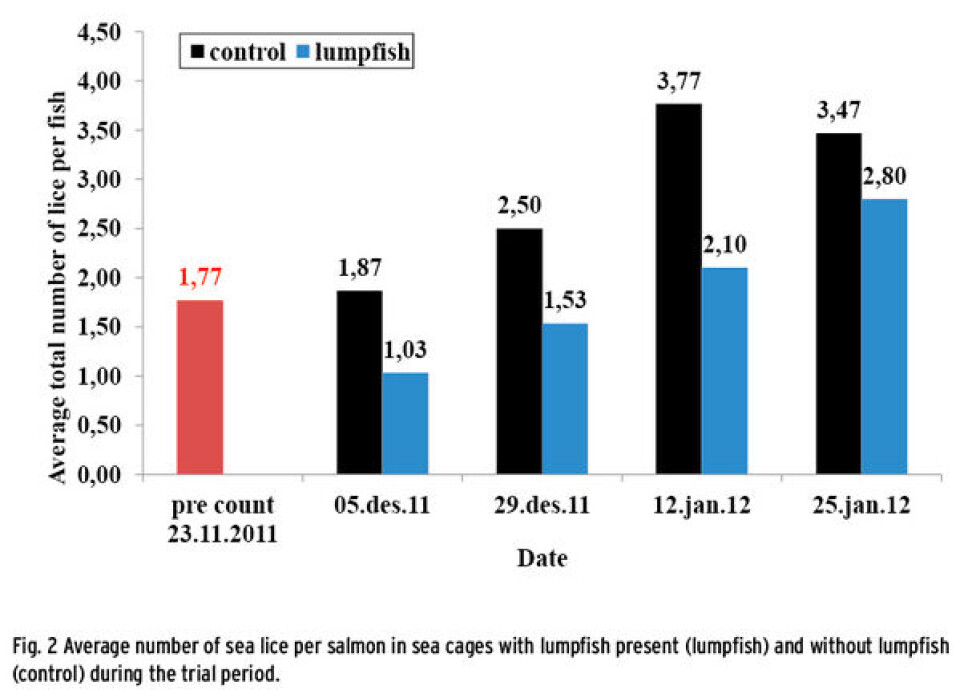
Financial support was given by the Norwegian Research Council (208614/E40) and the Mabit programme (AF0055).
























